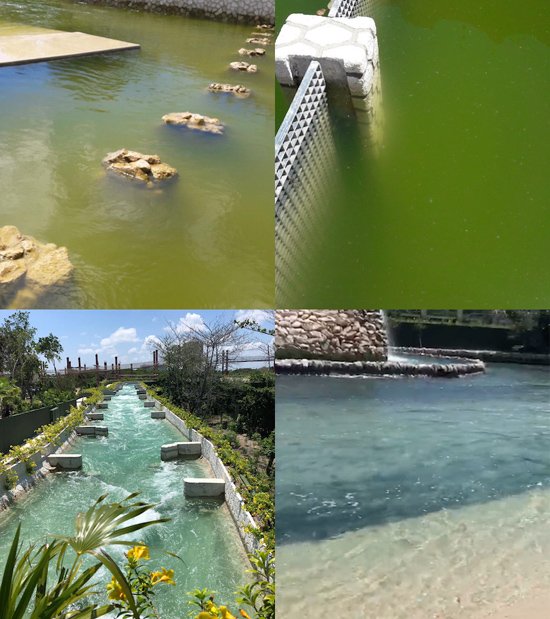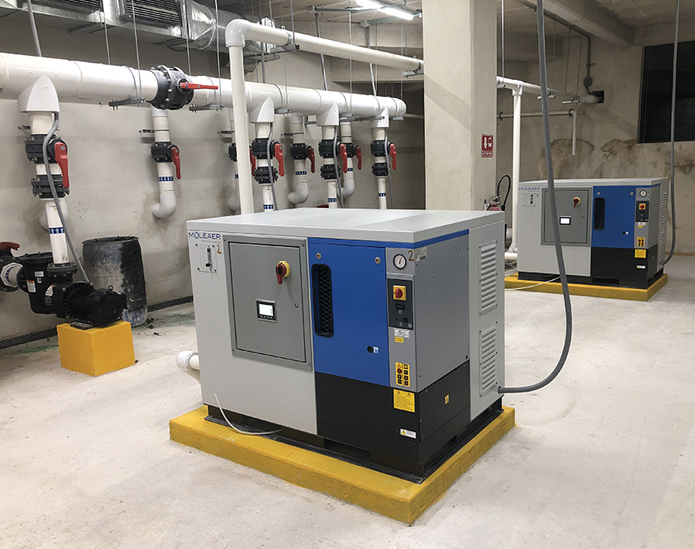
Ranging from microscopic, single-celled organisms to larger seaweeds, algae are simple, nonflowering aquatic plants with hundreds of different species. Algae play an essential role in the ecosystem and can provide an indication of overall pond health. As such, effectively managing algae growth is an important part of maintaining an attractive and healthy pond. While most algae species are not harmful, excessive algae growth is aesthetically unpleasing and can quickly become a maintenance problem. Some blooms, known as harmful algal blooms (HABs), produce harmful effects to people, animals and the local ecology. HABs can harm aquatic life by depleting water of oxygen, clogging fish and invertebrate gills and smothering plants and corals. Some blooms also produce toxins that can cause serious illness or even death in aquatic and land animals — and in extreme cases, humans. While the exact cause of HAB formation is not well understood, warm, stagnant, nutrient-rich, oxygen-depleted waters provide ripe conditions for excessive algae growth.
Over the last few years, the devasting impacts of HABs have affected every coastal U.S. state, as well as the states that border the Great Lakes. With the number of reported blooms on the rise, HABs are a growing threat to public health, and the need for an effective treatment method is gaining global attention.
Chemicals vs. Aeration
Until recently, two methods of algae control have been widely applied: chemical addition and conventional aeration.. The use of chemicals like herbicides and algicides, including copper sulfate, can be problematic because they do not selectively target algae. As such, they can indiscriminately degrade the health of the local ecosystem, including plants, fish and animals. Another drawback of chemical addition is the recurring annual cost of treatment.
Algae blooms can develop in water that is low in dissolved oxygen (DO). Algae blooms also consume DO in water, which can lead to fish kills, foul odors and poor water quality. Elevating DO in water is an all-natural, chemical-free approach to treating and controlling HABs, which is why aeration is often preferred to chemical treatments for managing algae growth. However, current aeration technologies have several limitations when it comes to efficiently elevating DO evenly throughout a body of water. Specifically, they only aerate a small portion of the water due to the rising motion of the bubbles. With conventional aeration, bubbles are introduced below the water surface, but their low density causes them to float to the surface and burst. This rising motion minimizes the amount of time that the bubbles are in contact with the water, leading to poor oxygen transfer, typically less than 2% per foot of water. Additionally, the oxygen transfer is localized to a small area surrounding the aeration device. Localized oxygen transfer can prohibit conventional aeration from effectively increasing DO levels in most waterbodies.
Introducing Nanobubbles
Recent technological advancements have enabled the production of extremely small bubbles known as nanobubbles. Since nanobubbles behave very differently from larger bubbles, they are able to overcome the oxygen-transfer limitations of conventional aeration technologies.
Nanobubbles are just what they sound like — incredibly small bubbles measuring less than 200 nanometers (nm) in size, or roughly 500 times smaller than the width of a human hair. At this size, nanobubbles exhibit unique properties that make them superior at dissolving oxygen into water. Nanobubbles are neutrally buoyant, meaning they do not rise to the surface and burst. Instead, they stay suspended in solution and disperse evenly throughout a waterbody by following random, erratic movement known as Brownian motion. Brownian motion allows the nanobubbles to traverse the waterbody to efficiently aerate the entire water column, even at the sediment surface. Delivering oxygen to the sediment layer is important because it reduces the release of nutrients, which helps to control algae growth.
Moleaer nanobubble technology produces a high concentration of stable nanobubbles, more than one billion per milliliter, as validated by third-party testing. At such incredibly high concentrations, nanobubbles have an enormous total bubble surface area in constant contact with the water, resulting in a 90% oxygen transfer efficiency irrespective of water depth. With nearly perfect oxygen transfer, nanobubbles elevate and maintain DO levels well beyond conventional aeration technologies, making nanobubbles an effective method for treating algae.
“Moleaer’s nanobubble generators provide the highest oxygen-transfer efficiency of any aeration technology I have tested so far,” said Michael Stenstrom, an aeration industry expert and distinguished professor at UCLA.
Sunshine State Solution
At a Florida pond plagued with algae issues, a Moleaer nanobubble generator was installed to improve water clarity and treat foul-smelling odors. Since higher temperatures reduce the DO-holding capacity of water, the pond struggled to maintain DO levels in the hot Florida sun. The low DO led to an anoxic environment at the sediment layer that allowed nutrients to cycle into the water, triggering an unsightly and malodorous HAB. After multiple unsuccessful chemical treatments, the pond owner needed a new solution to effectively manage algae growth.

After three weeks of generator operation, the DO approached saturation at all depths and at all points across the pond. Several months later, the Moleaer nanobubble treatment digested the six-inch muck layer at the bottom of the pond, leaving a transparent, sandy bottom visible through a clear and healthy pond. The nanobubble treatment also eliminated the need for further chemical treatments, which significantly reduced the cost of applying chemicals and the negative impact on the surrounding environment.
Eliminating Water Hazards
The city of Palm Springs, California, is famous for its warm weather and more than 100 meticulously manicured golf courses. This desert paradise, located in the southwest corner of the United States, is home to more than 1,000 ponds, lakes and ornamental waterbodies.
At a two-million-gallon pond located on a private golf course, the clarity of the water was very poor and unpleasant odors that emanated from the pond were the source of many complaints. The maintenance company hired to treat the pond was faced with a challenge, because they could not use conventional aerators for aesthetic reasons. The option to install blowers equipped with diffusers was also ruled out due to inadequate oxygen-transfer and the extent of submerged piping and associated maintenance that would be required.

Moleaer’s nanobubble generator presented a cost-effective and simple-to-install solution to disperse oxygen throughout the entire pond. Once installed at the Palm Springs golf course, the nanobubble generator quickly delivered oxygen to all reaches of the pond. Within the first week, the pond’s water clarity improved dramatically and foul odors were eliminated.
During the first month of nanobubble treatment, the DO level increased by 60%, and the Secchi disk readings improved by 42 inches. To verify whether the nanobubble treatment was responsible for the water clarity improvements, the system was turned off after collecting measurements on Aug. 17. Within two weeks, the Secchi disk readings decreased by 15 inches, so the nanobubble generator was turned back on. Within one week of resuming nanobubble treatment, the Secchi disk readings increased by 24 inches, confirming that the nanobubble treatment was responsible for the water clarity improvements.
A Better Xavage Experience

Xcaret, a resort in Playa del Carmen with over 50 natural and cultural attractions, is a popular spot for families to relax and vacation. One of their feature attractions is a 9.25-million-gallon water park called Xavage that features a lazy river. Xavage was experiencing unsightly and malodorous algae issues and was looking for a solution to alleviate the problem. After hearing about Moleaer’s success at treating algae with nanobubbles, they selected two 200-gallon-per-minute Moleaer Optimus nanobubble generators to treat their water.
The algae at Xcaret was caused primarily by the warm weather and nutrient runoff from fertilizer, which creates an environment conducive for algae growth. After installing the two nanobubble generators, Xcaret experienced a rapid improvement in water quality, measured by a significant increase in clarity, and a near total reduction in visible algae throughout the entire water park.
“The Moleaer Optimus gives us the tool to remove algae from Xavage, the wild water rafting park,” said Ing. Jose Daniel Gonzalez Pech, the maintenance manager at Xoximilco. “After trying numerous other treatment methods, we are thrilled with the results we are seeing. The nanobubble treatment is also all-natural and has eliminated our need for chemical treatment, which translates to a better experience for our guests.

Bio:
Ion Danes joined Moleaer as the director of marketing in 2018, bringing more than 12 years of industrial marketing experience to the team. Prior to joining Moleaer, Ion developed and implemented global marketing strategies for Capstone Turbine and Industrial Motor Power. Having made the transition from power generation to aeration, Ion brings a unique perspective to Moleaer and its innovate line of products. Ion is a graduate of Pepperdine University, where he received his master’s in business administration with a global marketing emphasis.

